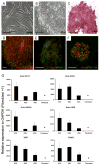Trophoblast lineage cells derived from human induced pluripotent stem cells
- PMID: 23774580
- PMCID: PMC3750115
- DOI: 10.1016/j.bbrc.2013.06.016
Trophoblast lineage cells derived from human induced pluripotent stem cells
Abstract
Background: During implantation, the blastocyst trophectoderm attaches to the endometrial epithelium and continues to differentiate into all trophoblast subtypes, which are the major components of a placenta. Aberrant trophoblast proliferation and differentiation are associated with placental diseases. However, due to ethical and practical issues, there is almost no available cell or tissue source to study the molecular mechanism of human trophoblast differentiation, which further becomes a barrier to the study of the pathogenesis of trophoblast-associated diseases of pregnancy. In this study, our goal was to generate a proof-of-concept model for deriving trophoblast lineage cells from induced pluripotency stem (iPS) cells from human fibroblasts. In future studies the generation of trophoblast lineage cells from iPS cells established from patient's placenta will be extremely useful for studying the pathogenesis of individual trophoblast-associated diseases and for drug testing.
Methods and results: Combining iPS cell technology with BMP4 induction, we derived trophoblast lineage cells from human iPS cells. The gene expression profile of these trophoblast lineage cells was distinct from fibroblasts and iPS cells. These cells expressed markers of human trophoblasts. Furthermore, when these cells were differentiated they exhibited invasive capacity and placental hormone secretive capacity, suggesting extravillous trophoblasts and syncytiotrophoblasts.
Conclusion: Trophoblast lineage cells can be successfully derived from human iPS cells, which provide a proof-of-concept tool to recapitulate pathogenesis of patient placental trophoblasts in vitro.
Keywords: Human indcued pluripotent stem cells; Trophoblast lineage cells.
Copyright © 2013 Elsevier Inc. All rights reserved.
Figures




Similar articles
-
Roles of CDX2 and EOMES in human induced trophoblast progenitor cells.Biochem Biophys Res Commun. 2013 Feb 8;431(2):197-202. doi: 10.1016/j.bbrc.2012.12.135. Epub 2013 Jan 8. Biochem Biophys Res Commun. 2013. PMID: 23313847 Free PMC article.
-
Two distinct trophectoderm lineage stem cells from human pluripotent stem cells.J Biol Chem. 2021 Jan-Jun;296:100386. doi: 10.1016/j.jbc.2021.100386. Epub 2021 Feb 5. J Biol Chem. 2021. PMID: 33556374 Free PMC article.
-
Current Strategies of Modeling Human Trophoblast Using Human Pluripotent Stem Cells in vitro.Curr Protoc. 2023 Oct;3(10):e875. doi: 10.1002/cpz1.875. Curr Protoc. 2023. PMID: 37787612 Free PMC article.
-
Early differentiation and gene expression characteristics of trophoblast lineages†.Biol Reprod. 2023 May 10;108(5):709-719. doi: 10.1093/biolre/ioad027. Biol Reprod. 2023. PMID: 36892411 Review.
-
Epigenesis and plasticity of mouse trophoblast stem cells.Cell Mol Life Sci. 2016 Feb;73(4):757-74. doi: 10.1007/s00018-015-2086-9. Epub 2015 Nov 5. Cell Mol Life Sci. 2016. PMID: 26542801 Free PMC article. Review.
Cited by
-
Establishment of human trophoblast stem cells from human induced pluripotent stem cell-derived cystic cells under micromesh culture.Stem Cell Res Ther. 2019 Aug 7;10(1):245. doi: 10.1186/s13287-019-1339-1. Stem Cell Res Ther. 2019. PMID: 31391109 Free PMC article.
-
BMP4 regulation of human trophoblast development.Int J Dev Biol. 2014;58(2-4):239-46. doi: 10.1387/ijdb.130341mp. Int J Dev Biol. 2014. PMID: 25023690 Free PMC article. Review.
-
Omics Approaches to Study Formation and Function of Human Placental Syncytiotrophoblast.Front Cell Dev Biol. 2021 Jun 15;9:674162. doi: 10.3389/fcell.2021.674162. eCollection 2021. Front Cell Dev Biol. 2021. PMID: 34211975 Free PMC article. Review.
-
Stem Cell-Based Trophoblast Models to Unravel the Genetic Causes of Human Miscarriages.Cells. 2022 Jun 14;11(12):1923. doi: 10.3390/cells11121923. Cells. 2022. PMID: 35741051 Free PMC article. Review.
-
Primary Trophoblast Cultures: Characterization of HLA Profiles and Immune Cell Interactions.Front Immunol. 2022 May 13;13:814019. doi: 10.3389/fimmu.2022.814019. eCollection 2022. Front Immunol. 2022. PMID: 35634345 Free PMC article.
References
-
- Honnma H, Baba T, Sasaki M, Hashiba Y, Ohno H, Fukunaga T, Endo T, Saito T, Asada Y. Trophectoderm morphology significantly affects the rates of ongoing pregnancy and miscarriage in frozen-thawed single-blastocyst transfer cycle in vitro fertilization. Fertil Steril. 98:361–7. - PubMed
-
- Hemberger M. Health during pregnancy and beyond: Fetal trophoblast cells as chief co-ordinators of intrauterine growth and reproductive success. Ann Med. 44:325–37. - PubMed
-
- Erb TM, Schneider C, Mucko SE, Sanfilippo JS, Lowry NC, Desai MN, Mangoubi RS, Leuba SH, Sammak PJ. Paracrine and epigenetic control of trophectoderm differentiation from human embryonic stem cells: the role of bone morphogenic protein 4 and histone deacetylases. Stem Cells Dev. 20:1601–14. - PMC - PubMed
Publication types
MeSH terms
Grants and funding
LinkOut - more resources
Full Text Sources
Other Literature Sources

